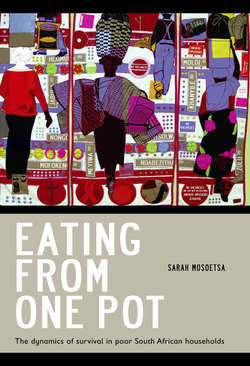Читать книгу Eating from One Pot - Sarah Mosoetsa - Страница 6
На сайте Литреса книга снята с продажи.
INTRODUCTION
ОглавлениеPoverty is an ever-present reality in contemporary South Africa. The distribution of wealth in the country is heavily skewed towards the rich. Despite a radical increase in social welfare over the last decade and a half, the vast majority of households remain poverty-stricken. While the poor are heavily reliant on the state for income in the form of social grants, the majority of people are not eligible for them. This means that the meagre income derived from grants has to support many people besides their intended beneficiaries. A quarter of South Africans are jobless in terms of the official definition of unemployment.1 When the entire economically active population is taken into account, however, the figure rises to a staggering 32 per cent. Unemployment is likely to get even worse as wage employment declines further. Given this grim picture, the burning question becomes: ‘How do the poor survive?’ This book provides an answer on the basis of evidence from case studies of households in the townships of Enhlalakahle and Mpumalanga in KwaZulu-Natal. It shows that many households are on the brink of collapse. That they keep going at all can largely be attributed to the struggles of older women against poverty. They are the fulcrum on which household survival turns.
Poor households are sites of both stability and conflict. In the absence of waged employment, working class households are the only source of security for many of the poor. People can still call on an ethos of sharing and communal support. In the words of one of the people who was interviewed for this book: ‘We eat from one pot and should always help each other.’ A recurring refrain in the interviews was: ‘I have to share the little I have with my family.’ Despite the sentiments expressed in this sort of statement, however, it is clear that practices of solidarity and sharing are being steadily eroded by adverse social and economic conditions. Social relations are frequently inharmonious and resources are not always equally shared. In fact, the case studies that are explored in this book suggest that in times of crisis there is more conflict than cooperation in the poorest households, a finding which accords with Amartya Sen’s (1990) notion of co-operative conflict.
Poverty undermines the collective nature of households. Struggles over the control of household income become prevalent. The money that is derived from state grants and employment in the informal economy covers little more than the cost of the most basic foodstuffs. The fault lines in conflicts over access to household income are frequently generational and gender-based. The elderly recipients of pension grants become victims of violence and abuse. Men feel humiliated by the loss of their role as provider for the family. Their frustration often takes the form of domestic violence and alcohol abuse. The disjunction between men’s lack of economic power and their conventional role as head of the household is a common source of tension.
The lives of the women and men in the two townships that the book explores graphically illustrate the contradictions inherent in South Africa’s simultaneous political, social and economic transformation, which has been characterised by a crisis in the reproduction of social relations, society and capital. Indeed, the outcome of the intensification of capitalism in South Africa, along with the advent of neo-liberal and informational capitalism, could be described as a crisis in the production of life itself (Castells, 1998; Bakker & Gill, 2003; Mullings, 2009). This, of course, is not an altogether new phenomenon. The escalation of capitalism in the apartheid era, in conjunction with race legislation that placed restrictions on movement and access to land and resources, resulted in a crisis of social reproduction in poor African households across the country.2
This book argues that the crisis that is evident at both household and societal level today is inseparable from the crisis of the reproduction of capital in the country. The ineffectiveness of the state’s response to this crisis, through its social and economic policies, has resulted in the pursuit of precarious and survivalist livelihood activities at both household and community level. Many households are extremely poor; the majority of them rely on a total monthly income of less than R800. Overcrowding is the norm. The position of the woman who has to share her two-bedroom house with eleven children and grandchildren, which is described in the next chapter, is not uncommon. Food insecurity is widespread. There is an overreliance on maize meal, tea and sugar. One informant described tomatoes as a ‘luxury item’. Nevertheless, it is important to note that the poor are not passive victims. This is especially true of older women, many of whom show impressive qualities of energy and resourcefulness by engaging in informal sector activities such as sewing and street hawking, even though the income gained is very small. Many of them are also active in faith-based organisations, such as the Manyano Women’s Christian Movement, new community based organisations, like the Treatment Action Campaign (TAC), and home-based care associations.
